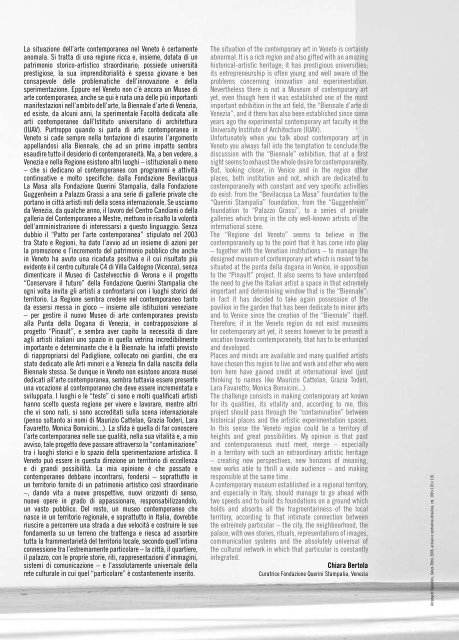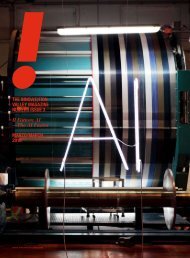PLEASE DISTURB - Fuori Biennale
PLEASE DISTURB - Fuori Biennale
PLEASE DISTURB - Fuori Biennale
Create successful ePaper yourself
Turn your PDF publications into a flip-book with our unique Google optimized e-Paper software.
La situazione dell’arte contemporanea nel Veneto è certamente<br />
anomala. Si tratta di una regione ricca e, insieme, dotata di un<br />
patrimonio storico-artistico straordinario; possiede università<br />
prestigiose, la sua imprenditorialità è spesso giovane e ben<br />
consapevole delle problematiche dell’innovazione e della<br />
sperimentazione. Eppure nel Veneto non c’è ancora un Museo di<br />
arte contemporanea, anche se qui è nata una delle più importanti<br />
manifestazioni nell’ambito dell’arte, la <strong>Biennale</strong> d’arte di Venezia,<br />
ed esiste, da alcuni anni, la sperimentale Facoltà dedicata alle<br />
arti contemporanee dall’Istituto universitario di architettura<br />
(IUAV). Purtroppo quando si parla di arte contemporanea in<br />
Veneto si cade sempre nella tentazione di esaurire l’argomento<br />
appellandosi alla <strong>Biennale</strong>, che ad un primo impatto sembra<br />
esaudire tutto il desiderio di contemporaneità. Ma, a ben vedere, a<br />
Venezia e nella Regione esistono altri luoghi – istituzionali o meno<br />
– che si dedicano al contemporaneo con programmi e attività<br />
continuative e molto specifiche: dalla Fondazione Bevilacqua<br />
La Masa alla Fondazione Querini Stampalia, dalla Fondazione<br />
Guggenheim a Palazzo Grassi a una serie di gallerie private che<br />
portano in città artisti noti della scena internazionale. Se usciamo<br />
da Venezia, da qualche anno, il lavoro del Centro Candiani o della<br />
galleria del Contemporaneo a Mestre, mettono in risalto la volontà<br />
dell’amministrazione di interessarsi a questo linguaggio. Senza<br />
dubbio il “Patto per l’arte contemporanea” stipulato nel 2003<br />
tra Stato e Regioni, ha dato l’avvio ad un insieme di azioni per<br />
la promozione e l’incremento del patrimonio pubblico che anche<br />
in Veneto ha avuto una ricaduta positiva e il cui risultato più<br />
evidente è il centro culturale C4 di Villa Caldogno (Vicenza), senza<br />
dimenticare il Museo di Castelvecchio di Verona e il progetto<br />
“Conservare il futuro” della Fondazione Querini Stampalia che<br />
ogni volta invita gli artisti a confrontarsi con i luoghi storici del<br />
territorio. La Regione sembra credere nel contemporaneo tanto<br />
da essersi messa in gioco – insieme alle istituzioni veneziane<br />
– per gestire il nuovo Museo di arte contemporanea previsto<br />
alla Punta della Dogana di Venezia, in contrapposizione al<br />
progetto “Pinault”, e sembra aver capito la necessità di dare<br />
agli artisti italiani uno spazio in quella vetrina incredibilmente<br />
importante e determinante che è la <strong>Biennale</strong>: ha infatti previsto<br />
di riappropriarsi del Padiglione, collocato nei giardini, che era<br />
stato dedicato alle Arti minori e a Venezia fin dalla nascita della<br />
<strong>Biennale</strong> stessa. Se dunque in Veneto non esistono ancora musei<br />
dedicati all’arte contemporanea, sembra tuttavia essere presente<br />
una vocazione al contemporaneo che deve essere incrementata e<br />
sviluppata. I luoghi e le “teste” ci sono e molti qualificati artisti<br />
hanno scelto questa regione per vivere e lavorare, mentre altri<br />
che vi sono nati, si sono accreditati sulla scena internazionale<br />
(penso soltanto ai nomi di Maurizio Cattelan, Grazia Toderi, Lara<br />
Favaretto, Monica Bonvicini...). La sfida è quella di far conoscere<br />
l’arte contemporanea nelle sue qualità, nella sua vitalità e, a mio<br />
avviso, tale progetto deve passare attraverso la “contaminazione”<br />
tra i luoghi storici e lo spazio della sperimentazione artistica. Il<br />
Veneto può essere in questa direzione un territorio di eccellenza<br />
e di grandi possibilità. La mia opinione è che passato e<br />
contemporaneo debbano incontrarsi, fondersi – soprattutto in<br />
un territorio fornito di un patrimonio artistico così straordinario<br />
–, dando vita a nuove prospettive, nuovi orizzonti di senso,<br />
nuove opere in grado di appassionare, responsabilizzandolo,<br />
un vasto pubblico. Del resto, un museo contemporaneo che<br />
nasce in un territorio regionale, e soprattutto in Italia, dovrebbe<br />
riuscire a percorrere una strada a due velocità e costruire le sue<br />
fondamenta su un terreno che trattenga e riesca ad assorbire<br />
tutta la frammentarietà del territorio locale, secondo quell’intima<br />
connessione tra l’estremamente particolare – la città, il quartiere,<br />
il palazzo, con le proprie storie, riti, rappresentazioni d’immagini,<br />
sistemi di comunicazione – e l’assolutamente universale della<br />
rete culturale in cui quel “particolare” è costantemente inserito.<br />
8<br />
The situation of the contemporary art in Veneto is certainly<br />
abnormal. It is a rich region and also gifted with an amazing<br />
historical-artistic heritage; it has prestigious universities;<br />
its entrepreneurship is often young and well aware of the<br />
problems concerning innovation and experimentation.<br />
Nevertheless there is not a Museum of contemporary art<br />
yet, even though here it was established one of the most<br />
important exhibition in the art field, the “<strong>Biennale</strong> d’arte di<br />
Venezia”, and it there has also been established since some<br />
years ago the experimental contemporary art faculty in the<br />
University Institute of Architecture (IUAV).<br />
Unfortunately when you talk about contemporary art in<br />
Veneto you always fall into the temptation to conclude the<br />
discussion with the “<strong>Biennale</strong>” exhibition, that at a first<br />
sight seems to exhaust the whole desire for contemporaneity.<br />
But, looking closer, in Venice and in the region other<br />
places, both institution and not, which are dedicated to<br />
contemporaneity with constant and very specific activities<br />
do exist: from the “Bevilacqua La Masa” foundation to the<br />
“Querini Stampalia” foundation, from the “Guggenheim”<br />
foundation to “Palazzo Grassi”, to a series of private<br />
galleries which bring in the city well-known artists of the<br />
international scene.<br />
The “Regione del Veneto” seems to believe in the<br />
contemporaneity up to the point that it has come into play<br />
– together with the Venetian institutions – to manage the<br />
designed museum of contemporary art which is meant to be<br />
situated at the punta della dogana in Venice, in opposition<br />
to the “Pinault” project. It also seems to have understood<br />
the need to give the Italian artist a space in that extremely<br />
important and determining window that is the “<strong>Biennale</strong>”:<br />
in fact it has decided to take again possession of the<br />
pavilion in the garden that has been dedicate to minor arts<br />
and to Venice since the creation of the “<strong>Biennale</strong>” itself.<br />
Therefore, if in the Veneto region do not exist museums<br />
for contemporary art yet, it seems however to be present a<br />
vocation towards contemporaneity, that has to be enhanced<br />
and developed.<br />
Places and minds are available and many qualified artists<br />
have chosen this region to live and work and other who were<br />
born here have gained credit at international level (just<br />
thinking to names like Maurizio Cattelan, Grazia Toderi,<br />
Lara Favaretto, Monica Bonvicini...).<br />
The challenge consists in making contemporary art known<br />
for its qualities, its vitality and, according to me, this<br />
project should pass through the “contamination” between<br />
historical places and the artistic experimentation spaces.<br />
In this sense the Veneto region could be a territory of<br />
heights and great possibilities. My opinion is that past<br />
and contemporaneous must meet, merge – especially<br />
in a territory with such an extraordinary artistic heritage<br />
– creating new perspectives, new horizons of meaning,<br />
new works able to thrill a wide audience – and making<br />
responsible at the same time .<br />
A contemporary museum established in a regional territory,<br />
and especially in Italy, should manage to go ahead with<br />
two speeds and to build its foundations on a ground which<br />
holds and absorbs all the fragmentariness of the local<br />
territory, according to that intimate connection between<br />
the extremely particular – the city, the neighbourhood, the<br />
palace, with own stories, rituals, representations of images,<br />
communication systems and the absolutely universal of<br />
the cultural network in which that particular is constantly<br />
integrated.<br />
chiara Bertola<br />
Curatrice Fondazione Querini Stampalia, Venezia<br />
Arcangelo Sassolino, Senza Titolo, 2006, acciaio e centralina idraulica, cm. 100 x 110 x 110.



